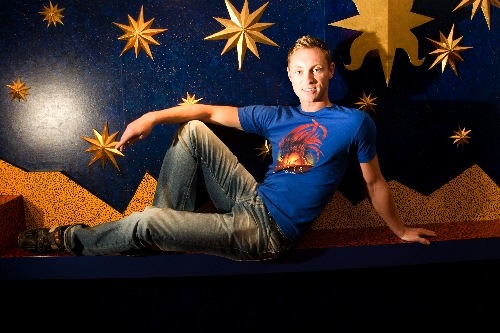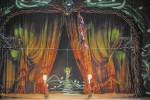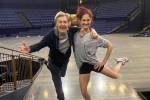Soaring determination leads gymnast to Mystère roost
For three years, British gymnast Ross Gibson made little headway in trying to land a part with Cirque du Soleil. The show would offer a part that did not interest him or he would suggest something that was not available.
In 2003, he switched from asking to demanding, an unconventional approach that would horrify most job-search consultants.
"I laid all my cards on the table and told Cirque that I only wanted to be a principal character," Gibson recalled. "I remember them telling me, 'Who are you to say that to Cirque du Soleil?' I told them, 'I'm no one, but I just know what I have to offer you.' "
His background included both acrobatics and dance training, an unusual combination for men. That, coupled with his burst of temerity, led in early 2004 to being cast as Red Bird, the lead role in Cirque's "Mystère."
Since then, he has become something of an oxymoron, a largely unknown Strip headliner. Red Bird is the face of "Mystère," including on the Treasure Island sign that faces Interstate 15. But due to the makeup and feathered headdress that go with his costume, few people ever pick him out as a star, even outside the theater after a show.
Gibson was fascinated by gymnastics while a boy growing up in the English coastal resort of Blackpool. His parents took him to a club where he started training in tumbling.
"Just running and throwing myself around was a huge thrill for me," he said, finding it less confining than working with rings or bars.
He also liked the solo aspect.
"I would just go to an open field and do as many somersaults and backflips as I could to impress myself and whoever was watching," he said. "I was definitely a performer and a show-off at a young age."
As a tumbler for the British national team, he was ranked as the third-best tumbler in the world at age 16 and came in second at the 2002 World Cup Final at age 22. He first auditioned with Cirque in 2000, but began training in dance with an eye toward landing a role in musical productions playing in London's West End theater district. When he finally came together with Cirque, he opted for a radical change in scenery.
That has included a large say in shaping the character. He would go to parks and study bird movements, keying in on the constant head movements.
He also retains major latitude in how to play Red Bird day in and day out.
"It's great with a principal character," he said. "While I'm on stage, I can be attracted by anything, whoever in the audience I want, whichever character I want, whichever sound from the musicians I want. I bring my own emotions to the role every day."
Question: You turned 30 this year, an elderly age in gymnastics. How long can you keep going?
Answer: I finished competing at age 23 after starting at age 10, so I had a good 13 years of competitive gymnastics. For men, gymnastics can go on a lot longer than it does for women.
The role I have is a very physically demanding role, probably one of the most demanding in Cirque. Very dance-based, very acrobatic-based. Always in character and very prominent on stage. It's a role I love so I want to continue as long as my body holds out. I've had my fair share of injuries and bruises and setbacks, but I'm hoping I have still another five years. In sports, 30 is old but not at Cirque, I think the average age of our performers (in "Mystère") is somewhere in the mid-30s. There's lots of veterans.
Question: How do you condition yourself to minimize the physical punishment?
Answer: I have a workout regimen twice a week with one of the personal trainers that Cirque provides us. I go to the gym myself. I take ballet and dance classes regularly. Just the show itself, an hour and a half 10 times a week, is enough to keep my body in shape. You just have to try to avoid those odd, random injuries that will pop up. It can be anything from stepping over a wall to doing a triple somersault. You can never really avoid the injuries and I've had a fair share of them. I just hope each time is the last time.
Question: Have you missed a move and had to limp through the rest of the show?
Answer: The main injury I've had came when I lost myself in the air, landed on my back and my knees went into my face, giving myself nine facial fractures in the middle of a show. Fortunately, I was on a mattress on wheels so I was very quickly wheeled off. There was lots of surgery to put my face back together with lots of metal. Six weeks later I was back in the show.
With injuries on stage, you fake your way through them. You find a way to make it look as if it never happened. The last thing an audience wants to see is a performer limping off. Any time I've hurt myself on stage, fortunately with my character, I can get down into my bird position on my knees and assess myself and work out how I am going to get off stage.
Question: Do you think of yourself as a tough guy?
Answer: To do what we do, 10 shows a week, 48 weeks a year, I think it's tough. It may not be your typical boxing ring fight toughness but it's definitely grueling on the body and something not everyone can do, for sure.
Question: When football players get injured, the game is stopped while they are on the ground. You can't do that.
Answer: I think they play on the sympathy. We can't because that will ruin a show for the audience.
Question: Do people recognize you on the street?
Answer: I'm starting to get a little more recognition now that I have been in the role for a while. You would think that once you walk outside the theater everybody would recognize you, but they very rarely do.
Question: Do you ever wish you had more of the celebrity that goes with a leading role?
Answer: Honestly, it would be nice to have a taste of heads turning when you walk down the street. But on the other hand, it could go the other way. If I had too much of that I might want to stick to the anonymity I have now. It would be nice to see what it's like for a while, but I am quite happy knowing myself that this is what I do and people enjoy it without having to tell it to my face.
Question: You don't speak except for bird squawk, but the sequence of routines are scripted. How much room do you have to improvise?
Answer: I have about 95 percent room to improvise. The work I do on stage is all choreographed by me. That's the best way of bringing yourself into a character, bring your own movements, your own stylization, your own mannerisms. I have to get from A to B on stage, but I can change it day to day as long as I keep it within the realm of a bird. You can play within whichever scope you feel like that day. If I'm sad that day I will play a sad bird. If I am happy that day, I'll play a happy bird.
Question: Does changing the role help keep you alert and avoid injury?
Answer: Yes, and I learn from my mistakes. That one time (I was injured), I just had that split-second lapse of concentration. If you do that flipping around 20 feet in the air in a dark environment with spotlights on you, a lapse will cause you to lose every sense of aerial awareness. You have to keep your head in the game and I learned from that time you never take for granted what you are doing on the stage or gymnastically.
Contact reporter Tim O'Reiley at
toreiley@reviewjournal.com or 702-387-5290.
VITAL STATISTICS
Name: Ross Gibson
Age: 30
Occupation: Red Bird in Cirque du Soleil’s “Mystère”
Quotable: “I have to get from A to B on stage, but I can change it day to day as long as I keep it within the realm of a bird. ... If I’m sad that day I will play a sad bird. If I am happy that day, I’ll play a happy bird.”
Family: In a relationship.
Education: Spelthorne School of Gymnastics in Ashford, U.K.; Laine Theater Arts in Epsom, U.K.; Bachelor of Arts in French and management at Royal Holloway University of London.
Work history: Member, Great Britain tumbling team; member, Las Vegas Contemporary Dance Theater; Dance with Royal Variety Show. Besides Red Bird, played roles in Cirque productions of ‘Kooza” and “Love.”
Hobbies: Gymnastics and dance.
Favorite book: Southern Vampire Mysteries, a series by Charlaine Harris.
Hometown: Blackpool, England.
In Las Vegas since: 2004.




























